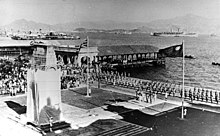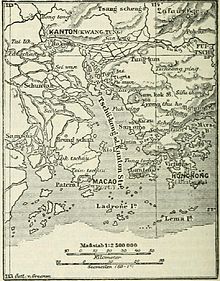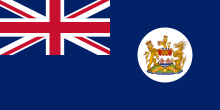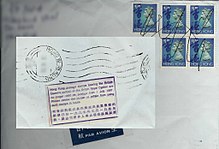History of Hong Kong
Prehistoric time
According to archaeological research that began in the 1920s, people have lived in this region for about 5,000 years. Excavations brought to light Neolithic artifacts that indicate the influence of North Chinese Stone Age cultures, for example the Longshan culture . Tools and weapons made of bronze were found on Lantau and Lamma Island . Stone engravings found in eight different locations across Hong Kong are dated to the Bronze Age ( Shang Dynasty ). Other artifacts dating from the 6th to 3rd centuries BC BC ( Warring States Period ) prove that the inhabitants of the region were culturally related to the inhabitants of neighboring Guangdong .
Chinese Empire
During the 2nd century ( Han Dynasty ) the area of what is now Hong Kong was settled by Han Chinese , which came to light through the excavation of an ancient burial site at Lei Cheung Uk in Kowloon . During the Tang Dynasty , the region around Guangzhou was an important trading center and the region of Hong Kong and what is now Shenzhen served as a port, and salt mining and pearl farming flourished. Nevertheless, the population initially remained very thin. The first major migration from northern China began during the Song Dynasty between 970 and 1279, as evidenced by excavations that have found coins and tools from the Song period.
After the Mongols conquered China , the Song rulers fled to what is now Kowloon . The Song surrendered in 1276, while two underage Song princes survived with their court until 1279. In the battle of Yamen the Mongols destroyed the last remains of the Song army, according to which a high official of the court is said to have thrown himself into the sea with the two princes. After the Yuan dynasty had also taken power over Hong Kong, immigration from the north increased again, but the region remained relatively isolated and lived from fishing and pearl farming.
Trade relations with Portugal
In 1517, the Portuguese trader Fernão Pires de Andrade landed on the south coast of China to negotiate with traders from Guangzhou . Records at the time show that the Portuguese fleet went ashore on a Tuen Mun island and killed some locals, this Tuen Mun being in what is now Hong Kong. Maps from that time, in which some larger settlements are shown in the territory, show that the originally purely agricultural settlement has now resulted in significant villages.
After the fall of the Ming dynasty and the annihilation of the exiled Ming on Taiwan under Koxinga , the region of what is now Hong Kong fell to the Xin'an district ( 新 安縣 , xīnānxiàn ). Emperor Kangxi set up fortifications and military camps to better defend the coast.
British Crown Colony
After the Portuguese in neighboring Macau had already set up a trading post, arrived in 1699, the British East India Company ( British East India Company ) for the first time to China. The trade in Hong Kong, mainly with the British merchants ( merchants ) grew from then on enormous and in 1711 a solid trading base in was Guangzhou founded.
Goods from China were in great demand in Europe, whereas the British found few goods to sell to the Chinese. So the British began to bring opium to China. When the imperial government tried to stop the opium trade, the first opium war broke out , which ended in the defeat of the Chinese and led to the occupation of Hong Kong by the British on January 20, 1841. Henry Pottinger became the first governor . One year later, with the Treaty of Nanking , the island of Hong Kong was officially ceded by China to the occupiers. On June 26, 1843, the instruments of ratification of the Treaty of Nanking were exchanged in Hong Kong and on this occasion the British Crown Colony was proclaimed. In 1860 the assignment of Kowloons followed and on June 9, 1898 the area north of Kowloons to the Shenzhen River (the New Territories ) and another 235 islands were leased for 99 years to ensure the supply of water and food to the crown colony and around the area to secure militarily.
The trade liberalization that was implemented after the Opium Wars made Hong Kong an important free trade area in East Asia, not only for the British but also for American traders. The rapid development suffered a severe setback with the outbreak of the bubonic plague in southern China in the 1890s .
Hong Kong became a haven for former Taiping , monarchists (after the founding of the republic in 1912) and communists (after Chiang Kai-shek's persecution in 1927). The population rose from 33,000 to 879,000 in 1851–1931, 95% of whom were Chinese.
The colony nonetheless remained in the shadow of greater Shanghai until 1949 , where the Communist Party was founded in 1921 and large strike movements took place in 1925. But Hong Kong's economic rise was also repeatedly disrupted after 1919 by strikes and revolutionary nationalist efforts among workers and seafarers. The most famous work stoppage lasted from June 19, 1925 to October 10, 1926.
See also: List of Hong Kong Governors
World War II and Chinese Revolution

Immediately after the outbreak of World War II in East Asia, the day after the attack on Pearl Harbor , Hong Kong was attacked by the Japanese army under Takashi Sakai . The defenders, including British, Canadians, Indians and Cantonese, were outnumbered and could not hold the territory very long; on December 25, 1941, after two and a half weeks of fighting , the British, under Governor Mark Aitchison Young , had to surrender to the Japanese. General Isogai Rensuke became the new governor during the almost four-year Japanese occupation of Hong Kong .
At the end of the Second World War, Hong Kong was a heap of rubble and a poor house, after which the civil war raged in China until 1949 . On October 1, 1949, the victorious communists proclaimed the People's Republic of China . Hundreds of thousands of counter-revolutionaries then fled China to Hong Kong, and many foreign companies relocated their offices from Shanghai to Hong Kong.
Difficult relationships
At the beginning of the 1950s, however, the crown colony first encountered another economic crisis, because an economic embargo against the newly founded People's Republic made the bridgehead function superfluous. After the embargo was lifted, Hong Kong experienced a boom thanks to its liberal economic policy and became an industrial center in a very small area. The immigrants provided some able and educated entrepreneurs, some cheap labor, which made Hong Kong's economy one of the most efficient in the world.
In the wake of the Cultural Revolution , violent social conflicts broke out in the 1960s, with the protest movement fighting for workers' rights on the one hand and being shaped by communist ideals on the other . The movement was violently suppressed.
After the death of Mao Zedong , his successor Deng Xiaoping began to open up China economically to other countries. One of the key measures was the establishment of special economic zones . For Hong Kong, Shenzhen , which is adjacent to the north, played an important role. As a result, almost all production companies from Hong Kong have migrated to China since the 1980s. The Hong Kong economy therefore had to reorient itself and Hong Kong became a center of trade and services.
Reintegration negotiations
During the Second World War there were already talks between the Republic of China and Great Britain about an early return of the New Territories , but this should only be decided after the end of the war. With the civil war in China after the defeat of the Japanese and the victory of the communists in 1949, the plan was abandoned by the British and instead Hong Kong was strengthened militarily.
In 1982 talks began between the Prime Ministers of the United Kingdom and the People's Republic of China on the future of the territory. The British side under Margaret Thatcher had originally hoped that opening up policies in China could lead China to accept British rule over the area. The opposite was the case: China not only demanded the return of the area leased for 99 years, but also the return of the territories ceded in the Nanking Treaty, as it rejected the treaty as unfair . This position had already been confirmed ten years earlier by a resolution of the General Assembly of the United Nations .
Deng Xiaoping , the most powerful man of the People's Republic of China at that time, was recognized, however, that an integration of Hong Kong to the People's Republic was not so easy and especially not in China's interest and therefore developed a doctrine known as One country, two systems known is. This doctrine paved the way for the Sino-British Joint Declaration on Hong Kong , signed on December 19, 1984 between the People's Republic of China and the United Kingdom. It stipulated that Hong Kong would become a Special Administrative Region (SAR) on July 1, 1997. After the signing of this agreement, the first wave of Hong Kong emigration broke out, who opposed China to take power. A second wave of emigration occurred in 1989 after the Tian'anmen massacre , which split Hong Kong society into a pro-Chinese and a pro-British camp. The main destinations for emigration were Australia , Canada , Singapore and the USA .
At the beginning of January 1990, the British government decided to grant 50,000 selected Hong Kong families (a total of 225,000 people) full British citizenship, which enables them to settle in Great Britain; in July 1989, the British Foreign Secretary in Hong Kong had only informed the citizens that they had not British passports cannot be granted permanent residence in the UK.
On April 4, 1990, the 3rd Plenum of the VII National People's Congress of the People's Republic of China in Beijing passed the Basic Law of the Hong Kong Special Administrative Region of the People's Republic of China.
In April 1990, the Alliance for Support of the Democratic Movement in China, founded in 1989 in response to the student protests in Beijing, merged with the United Democrats of Hong Kong (UDHK) . Martin Lee became its chairman.
In June 1991 the British government in Hong Kong enacted a " Bill of Rights " with the aim of safeguarding the fundamental freedoms of Hong Kong citizens. On July 4, 1991, the British and Chinese governments reached an agreement to build a new airport in Hong Kong, but there were repeated disagreements about the financing.
In July 1992, Chris Patten, the last British governor of Hong Kong, took office. He was the first professional politician to hold this position. He strained relations with the People's Republic by introducing liberal-democratic reforms (for example increasing the number of directly elected members in the legislative bodies), but above all by strengthening the political consciousness of Hong Kong people.
At the end of 1993 the Sino-British talks on Hong Kong broke off after 17 rounds of negotiations due to disagreement over the introduction of democratic elections in the Legislative Council. The People's Republic of China subsequently excluded British companies from bidding for the Guangzhou subway construction project .
In June 1994, the Legislative Council passed the electoral reforms proposed by Governor Christopher Patten. The PR China then announced that it would dissolve the elected legislative council with the handover on July 1, 1997.
In December 1995, the Chinese Working Commission of the Hong Kong Special Administrative Region, under the leadership of Qian Qichen, published a list of the members of the new Preparatory Commission, which is due to start its work in 1996. It consists of 56 representatives from the PRC and 94 representatives from Hong Kong and was officially established on January 26, 1996.
On March 31, 1996, the deadline for Hong Kong residents to apply for a British passport expired. In previous years, a total of 3.4 million British passports were issued with the option of visa-free travel to over 80 countries. However, this did not also include a right of residence in Great Britain.
Hong Kong becomes a Special Administrative Region
On July 1, 1997, the People's Republic of China took control of Hong Kong from the British in a major ceremonial act. Since then, Hong Kong has been a special administrative region . This means that it enjoys a high degree of autonomy in all political areas except foreign and defense policy . However, the Beijing government has repeatedly tried to undermine this autonomy. The most striking example of this was Article 23 of the Hong Kong Basic Law, the anti- subversion paragraph , against which half a million people demonstrated and at the same time demanded the resignation of the unpopular Chief Executive Tung Chee-hwa .
China's influence
In 2019, the Hong Kong government of Chief Executive Carrie Lam passed a controversial extradition law, which would allow the Hong Kong authorities to extradite people accused by China to the People's Republic. Critics feared that the Chinese judiciary was not independent. After demonstrations with up to 2 million participants , the government finally put this law on hold.
In June 2020, the Standing Committee of the People's Congress in Beijing Hong Kong passed a security law that primarily targets activities that Beijing regards as subversive, separatist or terrorist. It is also said to punish “collusion” between activists and forces from abroad. Life imprisonment is provided as the maximum penalty. The vote was passed unanimously by the 162 members of the Standing Committee and was thus added to the appendix to the Hong Kong Basic Law. Following the passage of the Security Law, leaders of the democracy movement have announced their resignation from their party.
Web links
Individual evidence
- ↑ Archive link ( Memento from September 16, 2006 in the Internet Archive )
- ↑ https://www.pdf-archive.com/2017/06/25/1898-06-09-hong-kong-convention-united-kingdom-china/1898-06-09-hong-kong-convention-united -kingdom-china.pdf 'Hong Kong Convention of June 9, 1898'
- ↑ ORF at / agencies sime: Hong Kong: Hundreds storm parliament. July 1, 2019, accessed July 1, 2019 .
- ↑ China passed controversial security law for Hong Kong - derStandard.at. Accessed June 30, 2020 (Austrian German).




